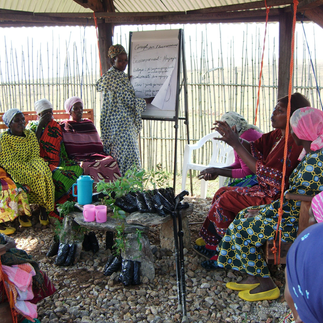Biodiversity Counts… in the Itombwe Rainforest
- Natalie Harvey
- Sep 4, 2023
- 3 min read
Updated: Nov 18, 2025
By Angela Mayson, Head of Restoration, TreeSisters

The Congo basin is the second-largest rainforest in the world. The South Kivu province in the Democratic Republic of Congo is home to the Itombwe Mountains, a vast contiguous mountain forest renowned for its incredible biodiversity, and a TreeSisters restoration site.
From giant mammals such as majestic elephants and fierce predators like leopards to tiny birds and beautiful butterflies, it is home to an astonishing ecosystem and a rich and ancient tapestry of plants, animals and microbes living together in a never-ending cycle of life.
Join me as we journey deep within the Itombwe Rainforest...

The ngagi (Swahili), or Eastern Mountain gorilla, is one of the families that call this forest home. Mothers with their young babies and teenagers are loosely gathered among the trees and swamps, while the dominant male keeps watch for predators.
The ngagi graze on the young bamboo shoots and enjoy nibbling on the arrowroot and pea or bean plants near the forest floor. They play in the trees, and as they move through the forest, they leave behind seeds, helping to spread new life throughout the area. The group’s dominant male is scanning the treetops in search of fruit. Once he spots some, he starts to push on the trunk. When the tree falls, pockets of light flow into the gaps, providing nourishing light to the seedlings below.
As the beam of sunlight streams through the canopy, it falls on the Green Swallowtail Butterfly - malachite green, with delicate wings; this is one of the many butterflies that live in these montane meadows.
Not far away, near the Elila River, the Marsh mongoose, climbing out of the flowing water with its shiny dark coat, lays down on the bank in the sun and turns on its back. A small bird notices the pink underside of its belly and flits down for the perfect meal. As the bird cautiously lands, the mongoose suddenly attacks and takes it to its nest for dinner.

The white-striped reed frog chirps among the dense riverside grasses as the river continues along its course. It is waiting for small insects to come by. But it knows it is vulnerable to the hunger of the brown-lipped snake.
Culminating our journey, the alert eyes of the Servaline genet focus on its prey. Its catlike body delicately prances along the tree branch before it pounces and takes a small rodent in its mouth. This small carnivore, known as Kanu in Swahili, with a foxlike face and dark spotted fur, has a kit in its burrow waiting to eat.
With your support, our project protects and restores the Itombwe forest, protecting its biodiversity and supporting all the creatures that call it home.
One of the trees we plant is the umuko, or flame tree, which feeds sunbirds whose long curved beak is perfect for reaching into the funnel-shaped flower to extract its sweet nectar.

The parasol tree, or Polyscias fulva, is also planted. This tree grows quickly and offers both shade and valuable wood for harvesting. Its small, honey-scented flowers also attract bees. When the tree bears fruit, the seeds are collected to begin the next restoration cycle for future generations of parasol trees.
Together with our partners, WECAN and SAFECO, over 700 local and indigenous women are planting bamboo and legumes and over 20 different types of trees to restore this depleted forest. These women, who have been restoring and protecting this forest for many years, are reporting increased rainfall where the forest has been replanted. New saplings, bushes and species are emerging through the rewilding of these spaces.
The impact we can have when we work together to preserve our natural world is incredible.

The Itombwe forest is a remarkable place, home to a vast array of creatures and plants, all interacting to maintain balance and harmony. The women living in this precious place are doing what they can to ensure that it thrives for future generations. We hope you make your donation count and support them to protect this beautiful and vital part of our world.
You can read more about our project protecting the Itombwe forest here.


















